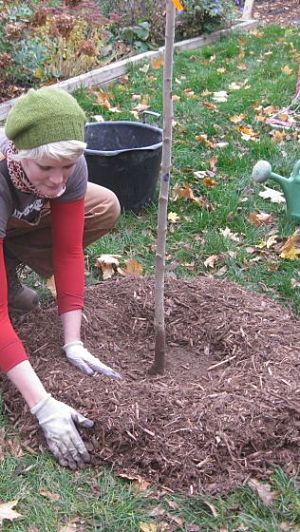Composting is earth’s natural recycling system: it turns organic waste into nutrients for trees and plants, helping them grow up strong and healthy. Compost is a completely natural fertilizer that replenishes the organic matter and nutrients that trees need. Plus it’s super easy to make and completely free!
All you need is a composter and some food scraps. You don’t need to look far to find materials you can use for compost—everything you need is already in your home! You can use leftovers from fruits and vegetables, coffee grounds, or any other organic food items found in your kitchen. Yard waste can also be used, including anything from weeds, dead plants, or leaves collected from raking. If your leaves have visible disease or fungus, include those in the yard waste collection since backyard composting may not reach temperatures adequate to kill pathogens. Also, be sure not to put meat, bones, or eggs in your compost either! Those go in your Green Bin.
You may also need an additional source of carbon to ensure a carbon/nitrogen balance. If your compost is dark, wet or smelly, adding strips of newspaper will help blance it out. Inks are usually made of vegetable dyes so no need worry about toxins!

The perfect recipe for nourishing compost!
Once everything’s in your composter, turn or mix it every 2-4 weeks to help speed up the decomposition process. Depending on the materials, the time it takes for the composting procedure to be completed varies. You’ll know it’s ready to use when your compost is dark and crumby, with nothing solid intact amongst it!
To use, sprinkle compost on the soil or grass around the trunk of your tree. Then cover the compost with a 2-3 inches of organic mulch (natural, undyed woodchips are ideal). Be sure not to allow the mulch to touch the trunk of your tree, as this can promote rot. Place it in a donut shape instead! All that’s left is to watch your trees thrive as the compost and mulch gradually decompose, improving the structure and organic matter content of the soil!

Observe the perfect donut shape this volunteer is creating. That is going to be one happy tree!
By turning your waste into compost, not only are you reducing your household waste, but you’re also putting it to good use. You’ll have better quality soil for your trees to live in—they’ll be sure to thank you by growing taller, stronger, and healthier!
Need more information? You can follow York Region’s Guide for Backyard Composting for step-by-step instructions. They make composting easy!
Not sure whether an item can be used for compost? Check out York Region’s Bindicator to find out! Determine if what you have can go into your composter, or if it’s better to go into your Green Bin or yard waste collector.
The Backyard Tree Planting Program is supported by York Region, City of Toronto, Toronto Hydro, the Town of Newmarket, the Town of Ajax and Oakvillegreen Conservation Association.
Kaila is LEAF's Planting Program Assitant.
Photos by David Slaughter and Adam Foley.
